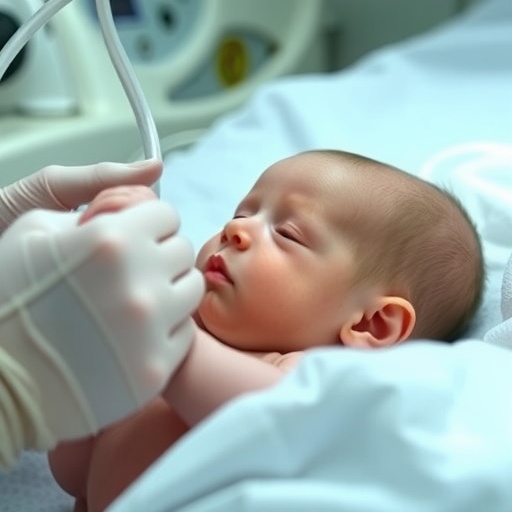High-frequency oscillatory ventilation (HFOV) has emerged as a pivotal therapeutic approach in the care of preterm neonates, particularly those born at extremely low gestational ages. Recent research, spearheaded by a team of experts including Kurimoto, Tokuhisa, and Yara, delves into the implications of this ventilation strategy on neonatal health, specifically investigating its association with the incidence of pneumothorax—one of the critical complications faced by these vulnerable infants. Their findings, published in BMC Pediatrics, highlight a troubling correlation that could compel a reevaluation of clinical practices in neonatal intensive care units (NICUs).
As neonatologists strive to optimize respiratory support for preterm infants, HFOV has gained traction due to its potential to provide effective ventilation while minimizing airway pressures. Traditional mechanical ventilation approaches often subject the lungs to significant stresses, particularly in neonates suffering from respiratory distress syndromes. In contrast, high-frequency oscillatory ventilation delivers rapid bursts of air, promoting gas exchange effectively without the excessive pressure that can harm delicate lung tissues. However, while the benefits of HFOV are considerable, understanding the trade-offs is crucial for clinicians.
The study in question elucidates a significant consequence of HFOV utilization—it appears to increase the risk of pneumothorax in neonates who are born at 22–25 weeks of gestation. Pneumothorax, which involves the accumulation of air in the pleural space leading to lung collapse, can result in severe respiratory distress, necessitating immediate intervention. In providing critical care to the most fragile patients, clinicians must weigh the potential life-saving advantages of HFOV against its associated risks, particularly when guiding treatment protocols for those born at the edge of viability.
The intricacies of lung physiology in neonates, especially their vulnerability to pressure and volume changes, play a vital role in this discussion. The pulmonary systems of infants born at such early gestational ages exhibit significant immaturity, characterized by poorly developed alveoli and reduced surfactant production. These factors predispose them to not only respiratory distress but also mechanical lung injury, underscoring the need for cautious application of advanced ventilation strategies like HFOV. The study’s findings serve as a critical reminder that innovations in neonatal care must be approached with a careful consideration of the risks versus benefits paradigm.
Moreover, the methodology employed in this research contributes to the validity of its findings. By examining a substantial cohort of neonates subjected to HFOV, the researchers were able to draw meaningful correlations between the mode of ventilation and the incidence of pneumothorax. This robust analysis not only amplifies the validity of their conclusions but also engages a broader dialogue within the medical community regarding the standard practices employed in NICUs around the world.
As pressure builds for neonatal units to transition toward newer ventilation strategies, the implications of this study cannot be ignored. The increase in pneumothorax incidents associated with HFOV suggests a need for heightened vigilance among healthcare providers. Clinicians must consider implementing additional monitoring protocols or refining the criteria for initiating HFOV in this specific population. This research invites a reexamination of current ventilation practices to ensure informed decision-making that prioritizes patient safety.
The discourse around HFOV and pneumothorax in preterm infants also extends into realms of predictive analytics and individualized treatment. As healthcare providers increasingly leverage technology and data analytics in clinical decision-making, understanding which infants stand to benefit most from HFOV versus traditional methods becomes critical. The study opens avenues for further research aimed at identifying specific biomarkers or clinical indicators that may predict which neonates are at higher risk for adverse outcomes.
Finding equilibrium between the advantages of cutting-edge ventilation technology and the inherent risks is paramount. Given the fragile state of infants born at the cusp of survival, healthcare professionals must collaborate to develop comprehensive guidelines tailored to this demographic, mitigating risks while maximizing therapeutic outcomes. The urgency of such efforts magnifies as the landscape of neonatal care continues to evolve, informed by ongoing research like that of Kurimoto and colleagues.
In contemplating the future of neonatal respiratory support, discussions must transcend clinical efficacy and delve into ethical considerations. The question of how to best serve a population at extreme risk poses moral dilemmas that practitioners must grapple with in tandem with the evolution of medical technologies. Transparency in communicating potential risks to families and ensuring shared decision-making will be fundamental to advancing neonatal care.
As this research progresses, the dialogue surrounding HFOV must remain dynamic, evolving with new evidence and clinical experiences. The medical community is urged to engage in active conversations, drawing from the findings of this study to shape the trajectory of interventions in neonatal intensive care. Continuous professional development and training for NICU staff in the implications of these findings will be essential to ensure that the best practices are effectively integrated into clinical protocols.
In conclusion, the published findings regarding the association between high-frequency oscillatory ventilation and increased pneumothorax risks in preterm infants present a call to action for neonatologists. As understanding deepens regarding the interplay between innovative therapies and inherent patient risks, proactive measures must be embraced. This research not only broadens the knowledge base for clinicians but also reinforces the imperative of patient-centered care in one of the most complex arenas of modern medicine.
The journey of exploring the implications of HFOV in neonatal care is far from over. As ongoing studies build upon the foundation laid by Kurimoto and his team, new insights will emerge, shaping the practices that ultimately govern care in neonatal intensive units. With shared experiences and continuous learning, healthcare providers can enhance their approach to supporting the tiniest of patients, innovating while maintaining a focus on safety.
The ongoing discourse in neonatal care is a testament to the commitment of researchers and clinicians who toil relentlessly to improve outcomes for vulnerable populations. As science progresses and new technologies unfold, a collective focus on understanding and mitigating the risks associated with these interventions will be crucial in paving the way for the future of neonatology.
Ultimately, the integration of research findings into clinical practice must be driven by a commitment to enhance patient care. Detailed attention to the implications of studies such as this one will empower healthcare providers, enabling them to make informed choices in a landscape where the stakes are often life and death. The future of neonatal respiratory support stands at a critical juncture, where knowledge, caution, and compassion must coalesce to foster an environment where every infant has the best chance of survival and health.
Subject of Research: The relationship between high-frequency oscillatory ventilation and the incidence of pneumothorax in preterm neonates.
Article Title: High-frequency oscillatory ventilation with sigh breath increases pneumothorax in neonates born at 22–25 gestational weeks.
Article References:
Kurimoto, T., Tokuhisa, T., Yara, A. et al. High-frequency oscillatory ventilation with sigh breath increases pneumothorax in neonates born at 22–25 gestational weeks.
BMC Pediatr 25, 850 (2025). https://doi.org/10.1186/s12887-025-06142-1
Image Credits: AI Generated
DOI:
Keywords: High-frequency oscillatory ventilation, pneumothorax, neonates, respiratory support, neonatal intensive care.
Tags: clinical research in pediatricscomplications of HFOV in neonatesevaluating ventilation trade-offshigh-frequency oscillatory ventilationimplications of ventilation strategieslung protection strategies for preemiesneonatal intensive care unit practicesneonatal respiratory distress syndromeneonatology advancementspneumothorax risk in preterm infantspreterm infant carerespiratory support for neonates





